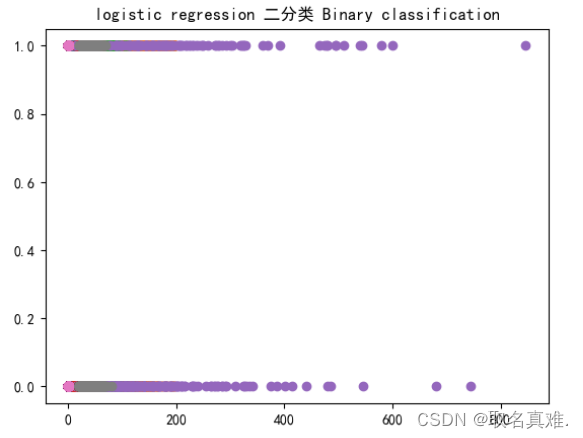Logistic Regression逻辑线性回归(基于diabetes数据集)
目录
2、ROC(Receiver Operating Characteristic)?
四、?ROC(Receiver Operating Characteristic)
介绍:?
Logistic Regression(逻辑回归)是一种用于解决分类问题的统计学习方法。它是线性回归的一种改进,主要用于处理二分类问题,也可以通过修改算法来处理多分类问题。
Logistic Regression的主要思想是通过线性回归模型的线性组合,将其映射到一个特定的函数(称为sigmoid函数)的输出范围内,从而将输入数据映射为一个概率值。sigmoid函数的输出范围为0到1之间,表示某个样本属于某个类别的概率。
Logistic Regression的训练过程是通过最大似然估计来求解模型参数。通常使用梯度下降等优化算法来最小化损失函数。在预测阶段,通过计算模型的输出概率值,并根据设定的阈值进行分类决策。
Logistic Regression具有简单、易于解释的优点,可以用于解决许多实际应用中的分类问题,如垃圾邮件过滤、信用风险评估、医学诊断等。然而,它也有一些限制,例如容易受到特征间相关性的影响,对于非线性分类问题的性能可能较差。
1、Confusion Matrix:
混淆矩阵(Confusion Matrix)是一种用于评估分类模型结果的方法。它以矩阵的形式展示了模型对样本的分类情况。
混淆矩阵的表格中有四个不同的结果:
真正类(True Positive,TP):模型正确地将正类样本分类为正类。
真负类(True Negative,TN):模型正确地将负类样本分类为负类。
假正类(False Positive,FP):模型错误地将负类样本分类为正类。
假负类(False Negative,FN):模型错误地将正类样本分类为负类。混淆矩阵通过统计分类结果的各个类别,可以计算出许多分类模型的性能指标,如准确率、召回率、精确率和F1-Score等。通过分析混淆矩阵,可以帮助我们对分类模型的性能进行评估和改进。
?
2、ROC(Receiver Operating Characteristic)?
ROC(Receiver Operating Characteristic)是一种用于评估分类模型性能的曲线,常用于二分类问题。在Logistic回归中,ROC曲线是通过改变分类模型的阈值而绘制出来的。
ROC曲线的横坐标是分类模型的假阳性率(False Positive Rate,FPR),纵坐标是分类模型的真阳性率(True Positive Rate,TPR),也就是分类模型的灵敏度(Sensitivity)。
在Logistic回归中,模型对样本进行概率预测,然后通过设定一个阈值将概率转化为分类标签。阈值越低,模型将更多的样本预测为阳性,从而会增加假阳性的数量,降低真阳性的数量;阈值越高,模型将更少的样本预测为阳性,从而会降低假阳性的数量,增加真阳性的数量。ROC曲线通过改变这个阈值,分别计算不同阈值下的FPR和TPR,然后将这些点连接起来得到。
ROC曲线越靠近左上角,表示分类模型的性能越好,因为这意味着在较低的假阳性率下能获得较高的真阳性率。ROC曲线下的面积(Area Under Curve,AUC)也是评估分类模型性能的重要指标。AUC的取值范围在0.5到1之间,越接近1表示模型性能越好。
?一、数据处理
import numpy as np
import pandas as pd
import matplotlib.pyplot as plt
from sklearn.linear_model import LogisticRegression#逻辑线性回归,结果是二分类
from sklearn.model_selection import train_test_split
from sklearn.metrics import confusion_matrix
data=pd.read_csv("diabetes.csv")
X=data.iloc[:,:-1]
y=data.iloc[:,-1]data:
plt.rcParams['font.sans-serif']=['SimHei']#用来正常显示中文标签
plt.rcParams['axes.unicode_minus']=False#用来正常显示负号
plt.plot(X,y,'o')
plt.title('logistic regression 二分类 Binary classification')
二、建模
X_train,X_test,y_train,y_test=train_test_split(X,y,test_size=0.3,random_state=0)#测试集占百分之三十,random_state=0随机抽取数据集里的成为测试集是一样的
X_train.shape
#结果:(537, 8)
X_test.shape
#结果:(231, 8)
logregression = LogisticRegression()
logregression.fit(X_train,y_train)#训练集赋给模型
y_predict=logregression.predict(X_test)#预测值
'''结果:
array([1, 0, 0, 1, 0, 0, 1, 1, 0, 0, 1, 1, 0, 0, 0, 0, 1, 0, 0, 0, 1, 0,
0, 0, 0, 0, 0, 1, 0, 0, 0, 0, 0, 0, 0, 1, 0, 0, 0, 1, 0, 0, 0, 1,
1, 0, 0, 0, 0, 0, 0, 0, 1, 1, 0, 0, 0, 1, 0, 0, 1, 0, 0, 1, 1, 1,
1, 0, 0, 0, 0, 0, 0, 1, 1, 0, 0, 1, 0, 0, 0, 0, 0, 0, 0, 0, 0, 0,
1, 0, 0, 0, 0, 0, 1, 0, 0, 1, 1, 0, 0, 0, 0, 0, 1, 0, 0, 0, 0, 1,
0, 0, 1, 0, 1, 1, 0, 1, 0, 1, 0, 0, 0, 0, 0, 0, 0, 0, 0, 0, 0, 0,
0, 1, 0, 0, 0, 0, 1, 0, 0, 1, 0, 0, 0, 0, 0, 0, 0, 0, 0, 1, 0, 0,
1, 0, 1, 0, 0, 1, 1, 1, 0, 0, 1, 0, 0, 0, 0, 0, 0, 0, 0, 0, 1, 0,
0, 0, 0, 0, 0, 1, 0, 1, 0, 0, 1, 0, 0, 0, 0, 0, 0, 0, 0, 1, 1, 0,
0, 0, 0, 0, 0, 0, 0, 0, 0, 0, 0, 0, 0, 0, 0, 0, 0, 0, 0, 0, 1, 0,
0, 0, 0, 1, 1, 1, 0, 0, 0, 0, 0], dtype=int64)
'''
logregression.score(X_test,y_test)#模型的精确率
#结果:0.7792207792207793三、?confusion_matrix
confusion_matrix(y_test,y_predict)
#结果:array([[141, 16],
# [ 35, 39]], dtype=int64)
from sklearn.metrics import classification_report
print(classification_report(y_test,y_predict))
#support的0=141+16,support的1=上面35+39
#presion的0 表示预测0的准确率, pression的1 表示预测1的准确率
#recall召回率 reacall的1=141/(141+35) recall的0=39/(39+35)
'''结果:
precision recall f1-score support
0 0.80 0.90 0.85 157
1 0.71 0.53 0.60 74
accuracy 0.78 231
macro avg 0.76 0.71 0.73 231
weighted avg 0.77 0.78 0.77 231
'''
print(logregression.coef_)#八项参数
'''结果:
[[ 0.0852812 0.03447238 -0.01082113 0.00636549 -0.0013322 0.08852981
0.73271467 0.02415028]]
'''
print(logregression.intercept_)#y轴切入
#结果:[-8.60539142]
四、?ROC(Receiver Operating Characteristic)
from sklearn.metrics import roc_auc_score
from sklearn.metrics import roc_curve
logrocauc=roc_auc_score(y_test,logregression.predict(X_test))
fpr,tpr,thresholds=roc_curve(y_test,logregression.predict_proba(X_test)[:,1])
plt.figure()
plt.plot(fpr,tpr,label='Logistic Regression (area=%0.3f)'%logrocauc)
plt.plot([0,1],[0,1],'r--')
plt.xlim([0.0,1.05])
plt.ylim([0.0,1.05])
plt.xlabel('False Positive Rate')
plt.ylabel('True Positive Rate')
plt.title('Receiver operating characteristic')
plt.legend(loc='lower right')
本文来自互联网用户投稿,该文观点仅代表作者本人,不代表本站立场。本站仅提供信息存储空间服务,不拥有所有权,不承担相关法律责任。 如若内容造成侵权/违法违规/事实不符,请联系我的编程经验分享网邮箱:veading@qq.com进行投诉反馈,一经查实,立即删除!